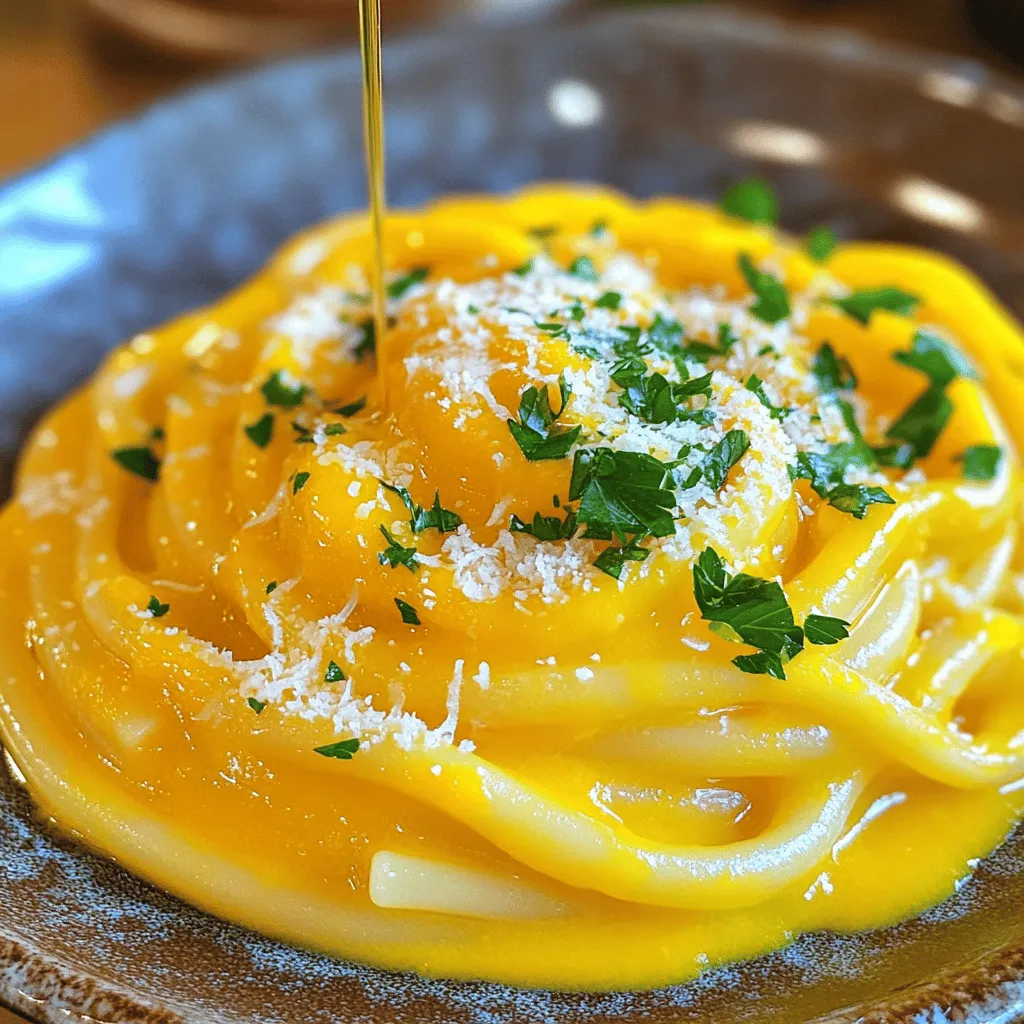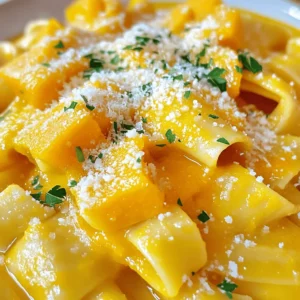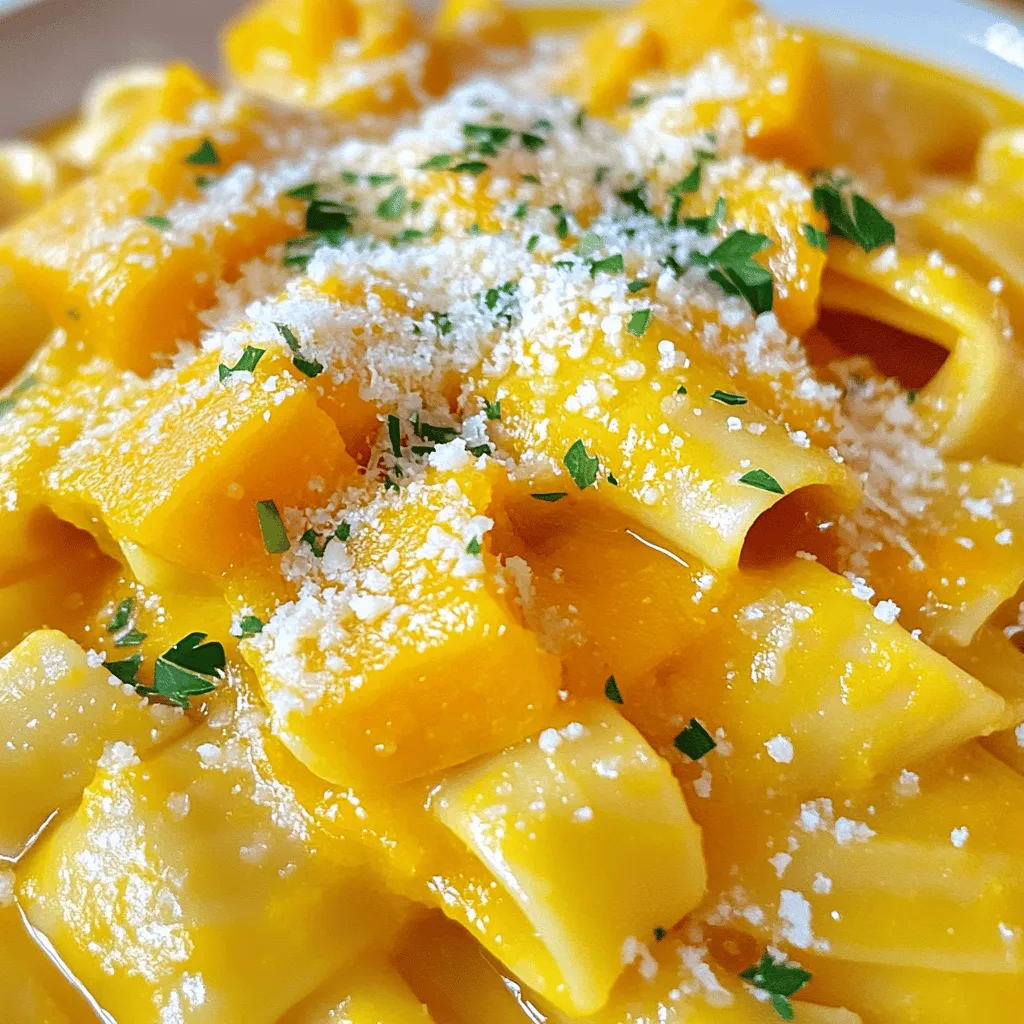If you’re looking for a tasty and easy meal, try butternut squash pasta sauce. This creamy, flavorful sauce will impress anyone at your table. Using fresh ingredients, you can whip it up in no time. Whether you prefer vegan or gluten-free options, there’s a twist for you. Ready to elevate your pasta game? Let’s dive into the delicious world of butternut squash sauce!
Ingredients
Main Ingredients for Butternut Squash Pasta Sauce
– 1 medium butternut squash, peeled and cubed
– 1 tablespoon olive oil
– 1 small onion, finely chopped
– 2 garlic cloves, minced
– 1 teaspoon fresh sage, chopped (or ½ teaspoon dried)
– ½ teaspoon ground nutmeg
– 1 cup vegetable broth
– ½ cup heavy cream (or coconut cream for a vegan option)
– Salt and pepper to taste
– ¼ cup grated Parmesan cheese (optional, or nutritional yeast for vegan)
– Fresh parsley, for garnish
– Cooked pasta of your choice (about 12 oz)
These ingredients create a rich and tasty sauce. The butternut squash gives a sweet and nutty flavor. Olive oil adds richness, while onion and garlic bring depth.
Optional Ingredients for Customization
Feel free to play with the flavors. You can add:
– Red pepper flakes for heat
– Thyme or rosemary for earthy notes
– Lemon juice for brightness
– Spinach for extra greens
Using these optional ingredients can make your sauce unique.
Suggested Pasta Choices
When it comes to pasta, choose what you love. Some great choices are:
– Spaghetti for a classic feel
– Penne for easy mixing
– Fettuccine for a hearty bite
– Gluten-free pasta for a lighter option
Pairing the sauce with the right pasta makes each bite enjoyable. For the full recipe, check out Butternut Bliss Pasta Sauce.
Step-by-Step Instructions
Preparing the Butternut Squash
First, preheat your oven to 400°F (200°C). Take your medium butternut squash, peel it, and cube it into small pieces. This helps it cook evenly. Spread the cubed squash on a baking sheet. Drizzle it with olive oil and sprinkle with salt and pepper. Toss it to coat the cubes well. Roast the squash in the oven for about 25 to 30 minutes. It should be tender and slightly caramelized when done.
Cooking the Aromatics
While the squash roasts, let’s prepare the aromatics. Heat a tablespoon of olive oil in a large skillet over medium heat. Add in your finely chopped onion. Sauté it until it turns translucent, which takes about 5 minutes. Next, add the minced garlic, chopped fresh sage, and ground nutmeg. Cook everything for about one minute until it smells amazing. This step builds a great base for your sauce.
Blending and Combining the Sauce
Once your butternut squash is ready, add it to the skillet with the onion and garlic. Pour in one cup of vegetable broth and bring this mixture to a simmer. Now, we need to blend it. You can use an immersion blender or transfer everything to a regular blender. If using a blender, be very careful of the hot steam. Blend until the sauce is nice and smooth. Return the blended sauce to the skillet and stir in half a cup of heavy cream (or coconut cream for a vegan touch). If you like, add grated Parmesan cheese for extra flavor. Cook this on low heat for about 5 minutes to let all the flavors meld together. Taste and add salt and pepper as needed. Finally, toss your cooked pasta in the sauce until it’s well coated. If the sauce is too thick, add a little more vegetable broth to get it just right. For the full recipe, check the complete guide above.
Tips & Tricks
How to Enhance the Flavor of the Sauce
To boost the flavor of your butternut squash sauce, think about adding herbs. Fresh sage is a great start. You can also try thyme or rosemary for a nice twist. A pinch of cinnamon adds warmth, too. For a kick, red pepper flakes work well. Remember, taste as you go. This helps you find the perfect balance.
Choosing the Right Pasta
When picking pasta, think about shape and texture. I love using whole wheat or gluten-free pasta for added nutrition. Shapes like penne or rigatoni hold the sauce well. If you want a delicate touch, try angel hair or fettuccine. Just make sure to cook the pasta al dente. This gives it a nice bite and helps it hold up in the sauce.
Adjusting Consistency and Creaminess
If your sauce seems too thick, don’t worry. You can simply add more vegetable broth. Start with a little and mix well, then check the texture. If you want creaminess, use heavy cream or coconut cream. This gives a rich feel without overpowering the squash. For a lighter sauce, try using just vegetable broth and a splash of lemon juice. This keeps it fresh and bright.
For the complete recipe, check out the Butternut Bliss Pasta Sauce.

Variations
Vegan Alternatives
If you want a vegan option, use coconut cream instead of heavy cream. This gives the sauce a rich taste without any dairy. You can also swap out Parmesan cheese for nutritional yeast. Nutritional yeast adds a cheesy flavor, making it perfect for vegan diets.
Gluten-Free Options
For those who need gluten-free meals, choose gluten-free pasta. Many brands offer great options made from rice, quinoa, or lentils. The butternut squash sauce pairs well with any gluten-free pasta. Just make sure to check the label for gluten-free certification.
Adding Protein to the Sauce
To boost the protein in the sauce, you can add cooked lentils or chickpeas. Both options mix well and add a hearty texture. You can also stir in shredded chicken or cooked sausage for meat lovers. This way, you create a filling meal that’s still packed with flavor.
For the full recipe, check out Butternut Bliss Pasta Sauce.
Storage Info
How to Store Leftover Butternut Squash Pasta Sauce
Store your leftover butternut squash pasta sauce in an airtight container. Make sure it cools before sealing. This helps keep it fresh. In the fridge, it lasts for about 3 to 5 days. Always check for any off smells or changes in color before using it again.
Freezing Instructions for Longer Storage
You can freeze the sauce for longer storage. Pour it into freezer-safe bags or containers. Leave some space at the top, as the sauce will expand. Label each bag with the date. It can stay in the freezer for up to 3 months. When you’re ready to use it, just thaw in the fridge overnight.
Reheating Tips for Best Results
To reheat, warm the sauce on the stove over low heat. Stir it often to heat it evenly. If it’s too thick, add a splash of vegetable broth. You can also microwave it in a safe dish. Heat in short bursts, stirring in between. This keeps the flavor fresh and delicious. Check out the Full Recipe for more tips!
FAQs
How do I make butternut squash pasta sauce creamy?
To make your butternut squash pasta sauce creamy, add heavy cream or coconut cream. This will give it a rich texture. You can also use a bit of grated Parmesan cheese for added creaminess. Blend the sauce until smooth before adding the cream. This helps mix everything well. If you want a lighter sauce, use vegetable broth instead of cream.
Can I use frozen butternut squash?
Yes, you can use frozen butternut squash. Make sure to thaw it first and drain any excess water. Frozen squash is often pre-cooked, which can save you time. Adjust your cooking time, as frozen squash may need less time to cook down.
What are some good pasta pairings for this sauce?
This butternut squash pasta sauce pairs well with various pasta types. I recommend using:
– Fettuccine
– Penne
– Rigatoni
– Farfalle
These shapes hold the sauce well. You can also try it with whole wheat or gluten-free pasta for a healthy twist. Don’t forget to toss your pasta in the sauce for a delicious meal. For the full recipe, check the link above.
Butternut squash pasta sauce is easy and fun to make. We explored main ingredients and ways to customize your dish. I shared step-by-step instructions to prepare and blend the sauce. You learned tips to enhance flavor and select the right pasta. We also discussed variations, storage methods, and answers to common questions.
This sauce is friendly for all diets. Experiment with flavors, and enjoy your meals!

